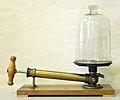Vacuum facts for kids
A vacuum is a space that has almost no matter in it. Imagine a place where there are hardly any tiny bits of stuff – that's a vacuum! Because there's so little matter, things like sound cannot travel through a vacuum. Sound needs particles to bounce off to move, and a vacuum doesn't have enough of them.
Even outer space is not a perfect vacuum. It's very, very empty, but there are still a few tiny particles floating around. So, while it's close, it's not completely empty.
Contents
Why Do We Need Vacuums?
Vacuums are super important for many things we do, especially in factories and science labs. People use special machines called vacuum pumps to suck out almost all the air and other gases from a sealed space, which is called a vacuum chamber.
It's actually impossible to create a 100% perfect vacuum here on Earth. But some powerful vacuum pumps can get rid of 99.9999% of the air! This super-empty space is called a hard vacuum. For most jobs, we don't need it to be that empty; even a 0.001% vacuum is often good enough.
Where Are Vacuums Used?
Vacuums are used in many different industries to make products or help with processes. Here are some examples:
- Food Industry: Vacuums help keep food fresh longer by removing air from packages. This stops germs from growing and makes food last on the shelf.
- Electronics Industry: When making computer chips or phone screens, even tiny dust particles can cause big problems. Vacuums keep these areas super clean so electronics work perfectly.
- Packaging: Many products, like coffee or medicines, are sealed in vacuum-packed bags or containers. This protects them from air and moisture.
- Moving Things: Special vacuum grippers can lift and move delicate items without touching them too hard. They use suction to hold onto objects.
- Coating and Degassing: Vacuums are used to put very thin layers of material onto surfaces, like the shiny coating on sunglasses. They also help remove unwanted gases from materials.
Scientists also use vacuum chambers for many experiments in their laboratories. Some experiments in physics and chemistry need a hard vacuum to study how things behave when there's almost nothing else around.
Everyday Vacuums Around You
You might not realize it, but vacuums are part of many things you use every day! For example, light bulbs often have a partial vacuum inside them, filled with a special gas like argon. This helps the tiny wire inside the bulb last much longer.
Even a simple water pump uses the idea of a vacuum. When you pump, it creates a lower pressure inside, and the outside air pressure pushes water up the pipe.
Related Pages
Images for kids
-
Evangelista Torricelli's mercury barometer produced one of the first sustained vacuums in a laboratory.
-
Light bulbs contain a partial vacuum, usually backfilled with argon, which protects the tungsten filament.
-
This shallow water well pump reduces atmospheric air pressure inside the pump chamber. Atmospheric pressure extends down into the well, and forces water up the pipe into the pump to balance the reduced pressure. Above-ground pump chambers are only effective to a depth of approximately 9 meters due to the water column weight balancing the atmospheric pressure.
-
Deep wells have the pump chamber down in the well close to the water surface, or in the water. A "sucker rod" extends from the handle down the center of the pipe deep into the well to operate the plunger. The pump handle acts as a heavy counterweight against both the sucker rod weight and the weight of the water column standing on the upper plunger up to ground level.
-
This painting, An Experiment on a Bird in the Air Pump by Joseph Wright of Derby, 1768, depicts an experiment performed by Robert Boyle in 1660.
See also
 In Spanish: Vacío para niños
In Spanish: Vacío para niños









